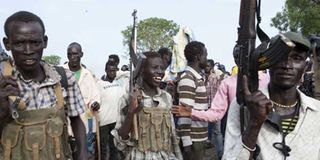The killing fields of South Sudan

Members of the White Army, a South Sudanese anti-government militia, attend a rally in Nasir on April 14, 2014. The UN has warned that the conflict presents a serious risk of famine that may kill up to 50,000 children within months if immediate action is not taken. PHOTO | ZACHARIAS ABUBEKER
What you need to know:
- Thousands dead and at least a million have fled their homes
- But these numbers do not convey the savagery that has been meted out on this people
Bodies lie in the street in Bentiu in Unity State South Sudan unwanted and uncollected. The dead have been left to bury their dead. The corpses are in advanced stages of decomposition, the skin parched and yielding to show bones underneath. This is just one of the photos coming from the world’s youngest nation.
The images from Kenya’s Northwestern neighbour are stomach churning.
They tell of a massacre where the violence has taken an ethnic flavour and is expressed with unmatched brutality.
The civil war is mutating into something nastier. South Sudan seems to have learnt from the brutality meted out by Khartoum and improved on the cruelty. The country is on the precipice of an abyss, the kind that made Rwanda infamous in the world.
Thousands dead and at least a million have fled their homes. But these numbers do not convey the savagery that has been meted out on this people.
The images available show the beginnings of extermination as the fighters on both sides target those least able to fight back. The old and the young are among the dead. The pregnant are not spared. The cruelty of man in South Sudan has surpassed the cruelty of the desert to the north of the country.
CRUDE SAVAGERY
In one photo, four dead men lie next to a minivan, the lower parts of their legs missing. One man is a quadruple amputee. The only foot visible in the image shows signs of having been hacked off. The rotten skin has sloughed off, exposing the men’s fibula and tibia.
It seems that the violence was meted out using crude weapons even as the guns roar. These killings indicate a regression to crude savagery. It isn’t just about killing the victims, it also includes torture and amputations before death.
The photographs and eyewitness reports hint at the depravity of the conflict.
There are photos of clothing ripped apart from the corpses to expose charred skin. The tops of the heads are hacked off. Recognizing some of the bodies would prove a challenge unless the latest advances of science are recruited.
The most worrying photo is one where the dead are being carried in an excavator destined for a mass grave.
The images make one instantly recall those that greeted the Allies in World War II as they liberated Bergen-Belsen concentration camp where the dead were similarly being buried using bulldozer.
In one image, a child lies dead, savagely gutted. In another, a heavily pregnant woman lies among the seven dead. One man’s ribs are clearly visible. There are United Nations trucks all over the area but help had clearly come too late.
There are queues of people waiting for food, shelter and flight; flight to any other place but not here.
In the wake of the massacres, hunger of untold magnitude looms. The UN has warned that the conflict presents a serious risk of famine that may kill up to 50,000 children within months if immediate action was not taken.
This carnage and death must compel the world to act. Kenya has interests in the region and should take the lead.
It cannot afford another unstable neighbour and an influx of refugees. More importantly it cannot sit by as the worst ethnic conflict in Africa in this decade is allowed to run its course unabated.





